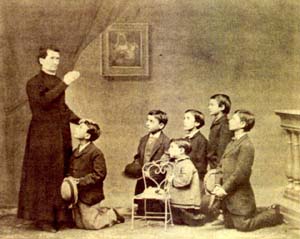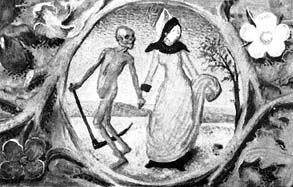 |
Catholic Virtues
The Sniper and the Novissima
Marian Therese Horvat, Ph.D.
The year, 1854. The scene, an auditorium of young men gathered to hear the spiritual lecture of the evening. Don Bosco entered, looked around the room and described a strange dream. He had seen a number of his boys on the playground, but one was draped in black and wearing a kind of tophat with the number 22 on it. He was confused about what this meant, until a dignified stranger appeared and told him that the lad had only 22 “moons” to live.
“I know who that lad is. He is right here among you,” the priest announced.

St. John Bosco at times would announce the imminent death of one of his boys |
Terror gripped the boys. This was the first time that Don Bosco had predicted the death of anyone in his school publicly and so solemnly. He noticed the fear and continued, “Don’t be afraid! True, I know that boy, and he is here now, but this is a dream, and you know that dreams are only dreams. One thing is certain, though – we must always be prepared, just as Our Divine Savior has warned us in the Gospel, and never commit sins. If we follow this rule, death will not frighten us. Put your conscience in order, therefore, and resolve not to offend God anymore. And on my part, I shall look after the boy of the 22 moons. These moons signify 22 months. I hope he will die a good death.”
The announcement caused an understandable fear among the boys. And, it did them good because each one began to consider the state of his soul should he be called to stand before God. The fear of God is the beginning of the wisdom. The focus on death kept the boys in God’s grace as they counted the months. At the end of the 22 months, one young man had a sudden attack of abdominal pains and died unexpectedly. He had made a general confession only a week before.
This was the first of a series of the dreams of St. John Bosco in which he saw the impending death of one of his boys. Each time, he announced to the auditorium that he had seen the boy, he knew him, but would tell no one, since it was only a dream. But he warned each one “to look after and correct himself, for while he wonders who it is, he himself may be just the one.” Each time, one of the boys would die within the prescribed time. Each time, the fervor of the whole group would increase, as the boys made more frequent and fervent Confessions and Communions, preparing themselves for the Novissima.
What are the Novissima? A first guess from the Latin novum might be that it is something new. In fact, it is the opposite. The superlative of novum, novissimus, means the latest, the last thing. And what are the novissima - the last things - that every man must face, regardless of position, wealth, or power? They are Death, Judgment, Heaven and Hell. Death: every man will die; it is a consequence of original sin. Judgment: everyone, even the atheist will stand before God to be judged. Heaven: eternal happiness for those who were friends of God and died in his grace. Hell: eternal punishment for those who were enemies of God or indifferent to him and die in the state of sin.

Death and the Lady – In this miniature from the Book of Hours (14th century), Death with his scythe in hand comes for the young, well-dressed lady who is thinking of other things |
The Church always taught that man should be prepared for the Novissima, the last things. It is what we pray in the Hail Mary: “Pray for us now and at the hour of our death.” It is a wise prayer because Scriptures makes us this great promise: “In all thy works, remember thy last end, and thou shalt never sin eternally” (Eccles 7:40). That is to say, one who meditates on the Novissima will not go to Hell. It is quite a promise, and it is why – until the progressivist catechesis that came from Vatican II which teaches that no one go to Hell – the pastors of the Church have always preached on the Novissima, the four last things. In the Age of Faith, consideration of the Novissima became a branch of learning, eschatology. Eschatology in Greek means the study of the last things. Today students have chemistry, biology, social sciences. But I’m afraid there isn’t much attention paid to the eschatology, the study of the last things.
Why do I bring all this up?
When I first read the stories of Dom Bosco, I thought how fortunate those boys were. The Saint entered the room and announced: “One of you will die. That is that. You can believe it or not. It was only a dream.” The boys believed the dreams because everything that he related actually came to pass. Therefore, those dreams forced them into seriousness about life. Death was no longer something distant, for the old, the weak, the sick. No, it could be I, a healthy young man, or anyone else in the room, and it could be soon. I better be prepared. And the confession lines would lengthen, and acts of piety and contrition would increase, as each one began to think about and prepare for death.
I remembered these stories of Dom Bosco as I read about the sniper in the Washington DC metropolis, who has stalked eleven victims and killed nine in the last month. Those are the figures as I write this column. Tomorrow, they could be larger. Therein lies the horror. One doesn’t know if he will be the next victim. The sniper chooses his victims randomly, with no discernible motive, except to kill. The last was a 47-year-old woman outside a crowded suburban shopping mall. Before that, a 53-year-old businessman pumping gas was felled by a single bullet. A teenage boy was hit on a middle school campus.
In a strange way, the whole Washington metropolis has become the auditorium of Dom Bosco, sans the Saint, most unfortunately. Suddenly, everyone is very aware that at any moment a shot could ring out, and another person could die.
How should a Catholic act in response to the possibility of unexpected death? He should follow the advice of Dom Bosco to his boys and be prepared. The bishops and priests should be at the pulpit reminding the flocks: you could go to Hell. It is enough to have committed one mortal sin, and at the moment the terrorist bullet hits, you may not have a chance to repent, to confess, to return to a state of grace. The last opportunity for that can be now.
I have heard people without Faith asking, “How can God permit such an atrocity?” One can still find the mercy God has for man in such a seemingly incomprehensible scenario. At times God permits a sudden death with the intention, among others, that many others might become frightened and turn to the path of virtue. Suddenly, a man begins to think on the novissima: I need to put my life in order, to consider not just the things of this life – my family, my house, my business, etc. I better have my soul in order because an eternity of happiness, or an eternity of suffering and Hell, depends on what I do now.
Who can think that catching this sniper will spell the end to this kind of terrorist or crazy acts? The “signs of the times” are around us: Just last week an explosion at a Finnish Mall killed seven and injured 80. Close to 200 tourists were killed in a blast outside a nightclub in Bali, Indonesia.
Yes, it is terrible. But it also a sign of the mercy of God that He allows us to glimpse the Damocles’ sword handing over the heads of us all - to invite us to think about death, and understand that things in this life are not worth anything except to the degree they help us to die well. Because if we die well, we will have eternal happiness sharing the happiness of God. If we die badly, we also will have eternity, but the eternal suffering of Hell. What a difference!
As Don Bosco with proverbial wisdom warned his sons: “Make hay while the sun shines. Let us not allow the devil to delude us into thinking we may put our consciences in order only at the moment of death.”
And he added: “For the Son of Man is coming at the time you least expect.”

Posted November 9, 2002
|
Catholic Virtues | Religious | Home | Books | CDs | Search | Contact Us | Donate

© 2002-
Tradition in Action, Inc. All Rights Reserved
|
 |
|